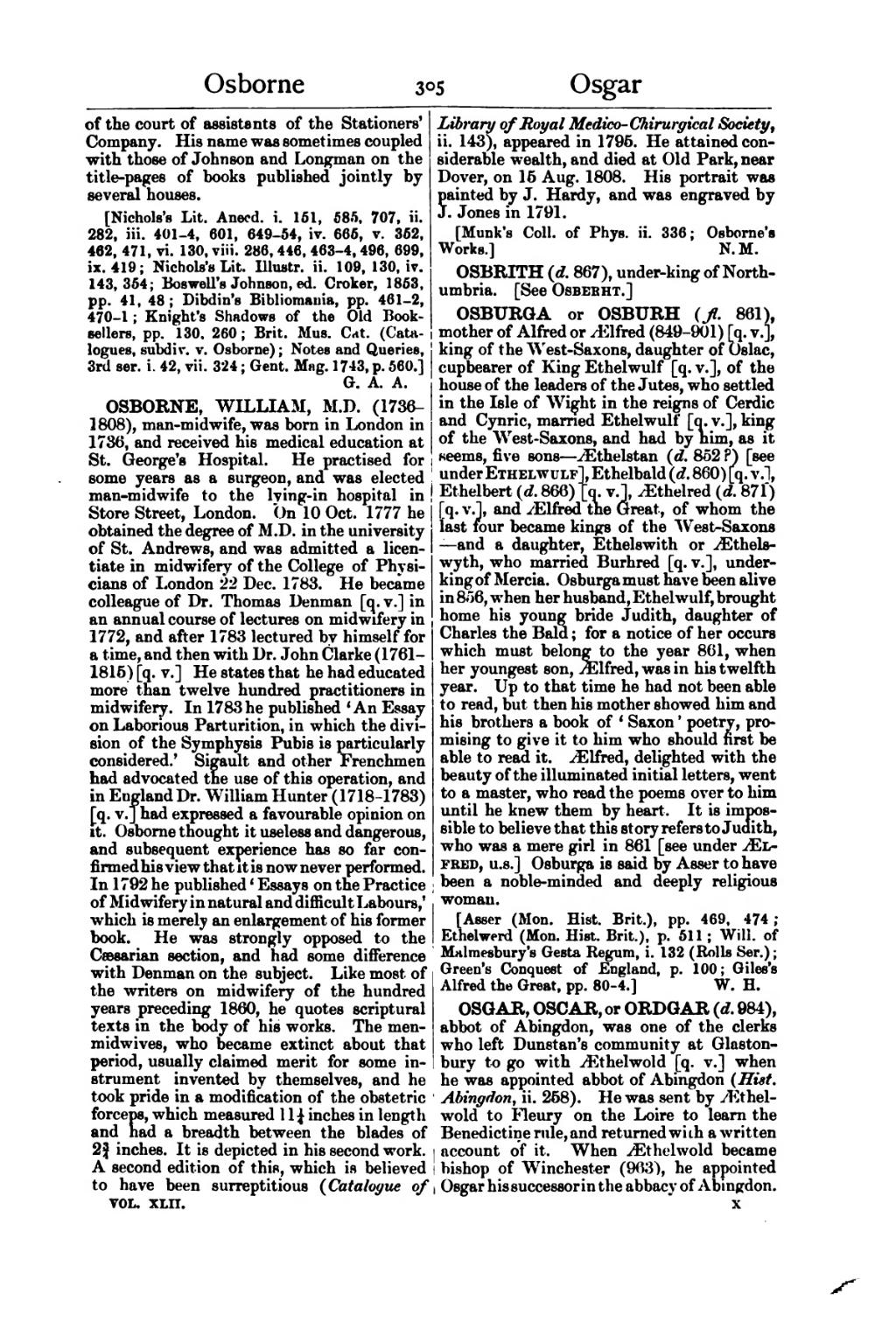of the court of assistants of the Stationers' Company. His name was sometimes coupled with those of Johnson and Longman on the title-pages of books published jointly by several houses.
[Nichols's Lit. Anecd. i. 151, 585, 707, ii. 282. iii. 401–4, 601, 649–54, iv. 665, v. 352, 462, 471, vi. 130, viii. 286. 446. 463–4, 496, 699, ix. 419; Nichols's Lit. Illustr. ii. 109, 130, iv. 143, 354; Boswell's Johnson, ed. Croker, 1853, pp. 41, 48; Dibdin's Bibliomania, pp. 461–2, 470–1; Knight's Shadows of the Old Booksellers, pp. 130. 260; Brit. Mus. Cat. (Catalogues, subdiv. v. Osborne); Notes and Queries, 3rd ser. i. 42, vii. 324; Gent. Mag. 1743, p. 560.]
OSBORNE, WILLIAM, M.D. (1736–1808), man-midwife, was born in London in 1736, and received his medical education at St. George's Hospital. He practised for some years as a surgeon, and was elected man-midwife to the lying-in hospital in Store Street, London. On 10 Oct. 1777 he obtained the degree of M.D. in the university of St. Andrews, and was admitted a licentiate in midwifery of the College of Physicians of London 22 Dec. 1783. He became colleague of Dr. Thomas Denman [q. v.] in an annual course of lectures on midwifery in 1772, and after 1783 lectured by himself for a time, and then with Dr. John Clarke (1761–1815) [q. v.] He states that he had educated more than twelve hundred practitioners in midwifery. In 1783 he published 'An Essay on laborious Parturition, in which the division of the Symphysis Pubis is particularly considered.' Sigault and other Frenchmen had advocated the use of this operation, and in England Dr. William Hunter (1718–1783) [q. v.] had expressed a favourable opinion on it. Osborne thought it useless and dangerous, and subsequent experience has so far confirmed his view that it is now never performed. In 1792 he published 'Essays on the Practice of Midwifery in natural and difficult labours,' which is merely an enlargement of his former book. He was strongly opposed to the Cæsarian section, and had some difference with Denman on the subject. Like most of the writers on midwifery of the hundred years preceding 1860, he quotes scriptural texts in the body of his works. The men-midwives, who became extinct about that period, usually claimed merit for some instrument invented by themselves, and he took pride in a modification of the obstetric forceps, which measured 11¼ inches in length and had a breadth between the blades of 2¾ inches. It is depicted in his second work. A second edition of this, which is believed to have been surreptitious (Catalogue of Library of Royal Medico-Chiruryical Society, ii. 143), appeared in 1795. He attained considerable wealth, and died at Old Park, near Dover, on 15 Aug. 1808. His portrait was painted by J. Hardy, and was engraved by J. Jones in 1791.
[Munk's Coll. of Phys. ii. 336; Osborne's Works.]
OSBRITH (d. 867), under-king of Northumbria. [See Osberht.]
OSBURGA or OSBURH (fl. 861), mother of Alfred or Alfred (849–901) [q. v.], king of the West-Saxons, daughter of Oslac, cupbearer of King Ethelwulf [q. v.], of the house of the leaders of the Jutes, who settled in the Isle of Wight in the reigns of Cerdic and Cynric, married Ethelwulf [q. v.], king of the West-Saxons, and had by him, as it seems, five sons—Æthelstan (d. 852?) [see under Ethelwulf], Ethelbald (d. 860) [q. v.], Ethelbert (d. 860) [q. v.] Æthelred (d. 871) [q. v.], and Ælfred the Great, of whom the last four became kings of the West-Saxons—and a daughter, Ethelswith or Æthelswyth, who married Burhred [q. v.], under-king of Mercia. Osburga must have been alive in 856, when her husband, Ethelwulf, brought home his young bride Judith, daughter of Charles the Bald; for a notice of her occurs which must belong to the year 861, when her youngest son, Alfred, was in his twelfth year. Up to that time he had not been able to read, but then his mother showed him and his brothers a book of 'Saxon' poetry, promising to give it to him who should first be able to read it. Ælfred, delighted with the beauty of the illuminated initial letters, went to a master, who read the poems over to him until he knew them by heart. It is impossible to believe that this story refers to Judith, who was a mere girl in 861 [see under Ælfred, u.s.] Osburga is said by Asser to have been a noble-minded and deeply religious woman.
[Asser (Mon. Hist. Brit.), pp. 469, 474; Ethelwerd (Mon. Hist. Brit.), p. 611; Will. of Malmesbury's Gesta Regum, i. 132 (Rolls Ser.); Green's Conquest of England, p. 100; Giles's Alfred the Great, pp. 80–4.]
OSGAR, OSCAR, or ORDGAR (d. 984), abbot of Abingdon, was one of the clerks who left Dunstan's community at Glastonbury to go with Æthelwold [q. v.] when he was appointed abbot of Abingdon (Hist. Abingdon, ii. 258). He was sent by Æthelwold to Fleury on the Loire to learn the Benedictine rule, and returned with a written account of it. When Æthelwold became bishop of Winchester (963), he appointed Osgar his successor in the abbacy of Abingdon.
